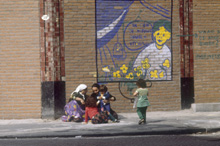Migrant workers > Migrant workers in the Netherlands
At this moment -2010- more than 3 million of the 16 million people living in the Netherlands are of foreign origin. After 1945, the Netherlands was confronted with three large immigration waves: from the colonies (Indonesia, Surinam and the Netherlands Antilles), from the countries around the Mediterranean Sea and from the Third World or countries embroiled in armed conflict. Most of the photos included in this collection concern the second immigration wave, which started in the 1960s and primarily included migrant workers from Turkey and Morocco. As a rule, these early migrants were given unskilled, heavy labor such as working in the coals mines. From the 1960s on, immigrant workers were employed in sectors such as the textile, shipbuilding and metal industry.
Opposition and integration
As time went by, more and more foreign workers sent for their families who then joined them in the Netherlands. The increase of their numbers met with opposition from the Dutch population. This opposition resulted in a first act of open violence in 1972: riots broke out in the Rotterdam district Afrikaanderwijk, where migrants were thrown out of their boardinghouses by their Dutch neighbors.
Integration did not become a major issue in politics, policies and social work until the late 1970s. Various organizations began to dedicate themselves to the cause of the migrant workers, such as the Aksiekomitee Pro Gastarbeiders - AKPG (Action committee for guest workers), the Stichting Hulp aan Buitenlandse Werknemers - SHBW (Foundation in support of foreign workers) and the Nederlands Centrum Buitenlanders - NCB (Netherlands centre for foreigners).
They endeavored to make sure the population groups were aware of each other's plight and to bring them closer together via the press, radio and television. The first publications with photographs of migrant workers appeared in the Netherlands in the 1970s.

